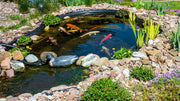
Ever taken a stroll past a pond and thought about what really inhabits it aside from the reeds and lily pads lining its edges? If you're like most people who get fascinated by such, then you probably have found yourself staring out over open water: full of life, yet mysterious. Whether you have a pond, manage a natural area, or simply like to learn about freshwater ecosystems, knowing what happens in that stretch of water away from the edges is crucial in appreciating health and biodiversity on a pond. This post explores the limnetic zone in some detail: what it is, why it's important, and how this particular zone dictates the nature of the pond.
Limnetic Zone of Pond-Definition

When we use the phrase "define limnetic zone of a pond," we refer to the open water area where sunlight can penetrate with sufficient intensity to support photosynthesis. This well-lit region teems with microscopic life that forms the foundation of the pond's food web.
· Light Penetration: This zone generally is from the water's surface down to the depth at which light penetrates sufficiently for photosynthesis to occur, which can be quite deep, depending on clarity.
· Place: In a pond, it starts where the littoral zone ends, basically, the shoreline area where rooted aquatic plants could occur, it spans the open waters of the center.
· Primary Residents: Here, planktons-both phytoplanktons and zooplanktons-are in plenty, while fish depend on them as important planktonic communities for food.
Simpler still, as you embark on defining the limnetic zone of the pond, you underline that portion of sunlit open water teeming with life. Its vibrancy is essential to keeping the pond ecosystem balanced and healthy.
A Closer Look at the Inhabitants
The limnetic zone contains many of the most important organisms in a pond's food web. Although fish are probably the first organisms one thinks about when considering open water, the true backbone of this zone's ecological dynamics is its rich plankton community.
1.Phytoplankton: Small, plant-like organisms (usually algae) that generate energy from sunlight and synthesize oxygen. They are the very base of the aquatic food chain.
2.Zooplankton: Small, mostly microscopic animals, including water fleas (Daphnia) and rotifers, feeding on phytoplankton themselves. They become a food source for fish.
3.Fish: Depending on the pond's size and conditions, species like sunfish, minnows, or trout may patrol the limnetic waters. They feed on zooplankton and other small prey, connecting the lower levels of the food web to higher trophic levels.
It is because of this complex web of life that the limnetic zone acts like such a huge driver of biodiversity within ponds. By generating energy from sunlight, the plankton feed not only themselves but also the fish and other creatures dependent on them.
Why the Limnetic Zone Matters
You may say to yourself, "So if most visible life appears to be concentrated around the shore, why bother trying to define the limnetic zone of a pond at all?" Here are a few reasons it's so crucial to understand this region of open water:
1.Primary Production: Phytoplankton capture sunlight to make energy through photosynthesis. This process forms the very base of almost every other living thing in the pond's ecosystem.
2.Oxygen Generation: Photosynthesis generates oxygen, benefiting fish and other oxygen-dependent species.
3.Nutrient Cycling: As plankton grow, reproduce, and become prey, nutrients cycle throughout the pond’s food web. Dead material eventually settles, feeding benthic organisms and replenishing nutrient levels.
4.Early Warning System: Shifts in plankton balance—like massive algae blooms or severely reduced zooplankton—can signal problems such as pollution or nutrient overload.
If the limnetic zone is out of balance, the whole pond suffers. The water may become cloudy due to algae blooms, fish become sparse, and the pond may become unsightly or even detrimental to wildlife and humans.
The Limnetic Zone vs. Other Pond Zones
To best understand the limnetic zone of a pond and see what makes it special, it helps to consider how it differs from the other adjacent zones:
· Littoral Zone: This is the near-shore area where sunlight reaches to the bottom, and rooted aquatic plants thrive. It supports a large number of insects, amphibians, and shoreline flora.
· Profundal/Benthic Zone: The deeper, darker part of a pond where sunlight can hardly penetrate. In smaller ponds, this usually merges with the bottom sediments. Organisms here adapt to low-light, low-oxygen conditions, including certain bacteria and bottom-feeding fish.
These distinctions serve to point out just why the limnetic zone, awash with sunlight and full of plankton, is so central to a pond's ecological well-being. It is, in effect, the powerhouse for photosynthesis in open waters.
Human Impacts on the Limnetic Zone
Natural as well as artificial ponds face different human-induced challenges. These may have serious repercussions on the sensitive balance within the limnetic zone:
1.Runoff and Pollution: Excess nutrients, generally nitrogen and phosphorus from fertilizers or pesticides, promote algal blooms, which temporarily enhance phytoplankton but, after it dies off, decreases oxygen levels.
2.Sedimentation: Soil erosion due to construction or deforestation clouds the water with sediment, which allows less sunlight to penetrate through, thereby slowing down the growth of phytoplankton organisms.
3.Invasive Species: Non-native fish or plants introduced either intentionally or accidentally may disrupt the pond's food web by outcompeting native species or altering water chemistry.
Being aware of these elements is the first way to preserve the limnetic zone. By minimizing pollution, controlling invasive species, and observing water clarity, you are bound to create a much healthier overall environment in the pond.
Maintaining a Healthy Limnetic Zone
If you’re responsible for a pond or simply passionate about local ecosystems, here are some practical steps to keep the limnetic zone in good shape:
· Water Testing: Regular checks on pH, dissolved oxygen, and nutrient levels help track changes in the limnetic zone, allowing for early interventions if problems arise.
· Responsible Landscaping: Application of less chemical fertilizer and putting vegetated buffer strips around the pond can stop runoff before it reaches the water.
· Aeration: Installation of an aerator or fountain promotes water circulation to prevent stagnation and maintains uniform levels of oxygen throughout.
· Fish Population Management: Stocking the pond judiciously with native or compatible fish species will avoid overpopulation. The latter may overgraze the zooplankton or smaller fish, besides causing ecological imbalance.
· Invasive Species Control: Keep an eye out for exotic plants or animals and remove them before they start disrupting the pond's food chain.
These measures guarantee a healthy limnetic zone through stabilized oxygen production, balanced nutrient cycling, and healthy plankton and fish populations for the benefit of all levels of life within the pond.
Conclusion
When you set out to define the limnetic zone of a pond, you will realize the hidden powerhouse of a pond's energy production and food web dynamics. Limnetic zone is far from being just open water; it teems with life dependent upon sunlight to drive photosynthesis-a process so crucial to the well-being of fish, amphibians, and even plants in nearby littoral zones.
In such a way, the appreciation of the limnetic zone allows one to maintain and care for the pond with its waters staying clear, its fish ample, and the environment vital. So the next time you stop and gaze across the water, remember that just beneath this glittering surface there is a whole community hard at work: a community that keeps this pond alive, balanced, and full of nature's magic.







